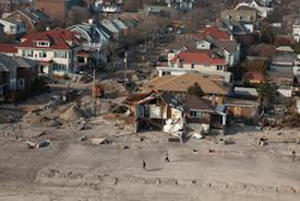Disaster recoveryNY to buy, demolish beachfront homes, make way for storm buffers
New York governor Andrew Cuomo plans to use $400 million in federal funding to buy beachfront homes as part of a broader plan to reshape the New York coastline so the state is better prepared for sea level rise, surges, and storms. The plan is to raze the purchased homes and leave to shore front vacant. Some properties would be turned into dunes, wetlands, or other natural buffers. Other parcels could be combined and turned into public parkland.

New York governor Cuomo proposes buying and demolishing beachfront homes to create a storm barrier // Source: fema.gov
New York governor Andrew Cuomo plans to use $400 million in federal funding to buy beachfront homes as part of a broader plan to reshape the New York coastline so the state is better prepared for sea level rise, surges, and storms.
Commissioner Joseph Martens of the Environmental Conservation Department said the funds will come from the $51 billion Congress approved last month as a regional relief package to help states and cities recover from the 29 October storm.
Bloomberg reports that the money would be used to pay owners the pre-storm – and pre-damage — value of their homes
In all, more than 300,000 houses in New York were damaged by Sandy.
The plan is to raze the purchased homes and leave to shore front vacant.
Last month, in his State of the State address, Cuomo raised the prospect of home buyouts, saying “there are some parcels that Mother Nature owns.”
“She may only visit once every few years,” Cuomo said, “but she owns the parcel and when she comes to visit, she visits.”
Martens, speaking yesterday at a budget hearing in Albany, said that “The goal is that when these buyouts occur, that the property be held as open space…. In some cases, there’ll be an opportunity to use those properties for shoreline protection.”
Also yesterday, a New York State Senate task force released preliminary recommendations on how New York should be better prepared for future storms. Among the recommendations of a panel established by Cuomo are proposals for building oyster beds, a rapid bus network, and storm barriers in New York Harbor. The cost of the various measures is estimated to be between $7 billion and $29 billion, depending on which recommendations are adopted.
The U.S. Housing and Urban Development Department (HUD) has approved Cuomo’s shore-line buyout plan.
Bloomberg notes that about 10,000 homes in the 100-year flood plain which were damaged by Sandy would qualify for buyouts. The Cuomo administration expects between 10 and 15 percent of home owners in the areas affected to accept the buyout offer.
The Cuomo plan calls for homeowners who relocate within the county in which they live to receive a 5 percent bonus above the market value of their home. Homeowners who live in surge-prone areas but who suffered little to no damage, would receive a 10 percent bonus above the market value of their home.
The administration plans to offer a 10 percent bonus to owners in the highest-risk areas – but only if everyone on the specific bloc agrees to take the buyout.
The New York Times notes that any reshaping of the coastline will be not only costly, but also difficult. Many residents of shoreline communities in New York City and on Long Island live in homes that have been passed along from generation to generation, and are not eager to hear government officials suggest that they move elsewhere, even voluntarily.
In parallel to the buyout plan, the Army Corps of Engineers has already agreed to do $150 million in repairs to existing coastal protections. The corps is considering work on other projects, including a new dune system to protect Long Beach.
Of the $51 billion Congressional relief package, the corps is getting almost $5.4 billion, including $1 billion for flood control.
Bloomberg reports that Cuomo expects New York to get about $30 billion of the funding, including $6.7 billion for fixes and flood preparation for transit agencies, including the New York City subway system, which saw the worst flooding in its more than 100-year history. The state Senate report said that about $8.1 billion is set aside for housing losses and $6 billion for businesses, and that Congress is also providing $462 million for government operating-revenue losses, the report said.
